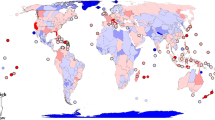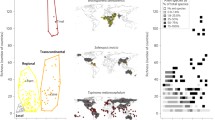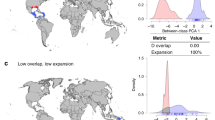Abstract
Many ants are among the most globally significant invasive species. They have caused the local decline and extinction of a variety of taxa ranging from plants to mammals. They disturb ecosystem processes, decrease agricultural production, damage infrastructure and can be a health hazard for humans. Overall, economic costs caused by invasive ants amount to several billion US $ annually. There is general consensus that the future distributions of invasive species are likely to expand with climate change, however this dogma remains poorly tested. Here we model suitable area globally for 15 of the worst invasive ant species, both currently and with predicted climate change (in 2080), globally, regionally and within the world’s 34 biodiversity hotspots. Surprisingly, the potential distribution of only five species was predicted to increase (up to 35.8 %) with climate change, with most declining by up to 63.3 %. The ant invasion hotspots are predominantly in tropical and subtropical regions of South America, Africa, Asia and Oceanic islands, and particularly correspond with biodiversity hotspots. Contrary to general expectations, climate change and invasive ant species will not systematically act synergistically. However, ant invasions will likely remain as a major global problem, especially where invasion hotspots coincide with biodiversity hotspots.




Similar content being viewed by others
References
Araújo MB, New M (2007) Ensemble forecasting of species distributions. Trends Ecol Evol 22:42–47
Araujo MB, Peterson AT (2012) Uses and misuses of bioclimatic envelope modelling. Ecology 93:1527–1539
Beaumont LJ, Gallagher RV, Thuiller W et al (2009) Different climatic envelopes among invasive populations may lead to underestimations of current and future biological invasions. Divers Distrib 15:409–420
Bellard C, Bertelsmeier C, Leadley P et al (2012) Impacts of climate change on the future of biodiversity. Ecol Lett 15:365–377
Bertelsmeier C, Luque GM, Courchamp F (2013a) Increase in quantity and quality of suitable areas for invasive species as climate changes. Conserv Biol 27:1458–1467
Bertelsmeier C, Luque GM, Courchamp F (2013b) Global warming may freeze the invasion of big-headed ants. Biol Invasions 15:1561–1572
Bolton B (2007) Taxonomy of the dolichoderine ant genus Technomyrmex Mayr (Hymenoptera: Formicidae) based on the worker caste. Contrib Am Entomol Inst 35:1–150
Brook BW, Sodhi NS, Bradshaw CJA (2008) Synergies among extinction drivers under global change. Trends Ecol Evol 23:453–460
Buisson L, Thuiller W, Casajus N et al (2010) Uncertainty in ensemble forecasting of species distribution. Glob Chang Biol 16:1145–1157
Butchart S, Walpole M, Collen B et al (2010) Global biodiversity: indicators of recent declines. Science 328(5982):1164–1168
Clavero M, García-Berthou E (2005) Invasive species are a leading cause of animal extinctions. Trends Ecol Evol 20:110
Cristianini N, Schölkopf B (2002) Support vector machines and kernel methods, the new generation of learning machines. AI Mag 23:31–41
De’ath G, Fabricius KE (2000) Classification and regression trees: a powerful yet simple technique for ecological data analysis. Ecology 81:3178–3192
Dukes JS, Mooney HA (1999) Does global change increase the success of biological invaders? Trends Ecol Evol 14:135–139
Elith J, Leathwick JR (2009) Species distribution models: ecological explanation and prediction across space and time. Annu Rev Ecol Evol Syst 40:677–697
Espadaler X, Bernal V (2009) Lasius neglectus–a polygynous, sometimes invasive, ant. http://www.creaf.uab.es/xeg/lasius/Ingles/distribution.htm. Accessed 1 May 2011
Essl F, Dullinger S, Rabitsch W et al (2011) Socioeconomic legacy yields an invasion debt. Proc Natl Acad Sci U S A 108:203–207
Fielding AH, Bell JF (1997) A review of methods for the assessment of prediction errors in conservation presence/absence models. Environ Conserv 24:38–49
Franklin J (2009) Mapping Species Distributions–Spatial Inference and Prediction. Cambridge University Press, Cambridge
Franklin J, Davis FW, Ikegami M et al (2012) Modeling plant species distributions under future climates: how fine-scale do climate projections need to be? Glob Chang Biol 19:473–483
Gallagher RV, Beaumont LJ, Hughes L, Leishman MR (2010) Evidence for climatic niche and biome shifts between native and novel ranges in plant species introduced to Australia. J Ecol 98:790–799
GIEC (2007) Climate Change 2007: Synthesis Report. An Assessment of the Intergovernmental Panel on Climate Change
Guisan A, Thuiller W (2005) Predicting species distribution: offering more than simple habitat models. Ecol Lett 8:993–1009
Guo QH, Liu Y (2010) ModEco: an integrated software package for ecological niche modeling. Ecography (Cop) 33:637–642
Gutrich JJ, VanGelder E, Loope L (2007) Potential economic impact of introduction and spread of the red imported fire ant, Solenopsis invicta, in Hawaii. Environ Sci Policy 10:685–696
Harris RJ, Rees J (2004) Ant Distribution Database. In: www.landcareresearch.co.nz/research/biocons/invertebrates/ants/distribution. Accessed 01 April 2011
Hayes KR, Barry SC (2008) Are there any consistent predictors of invasion success? Biol Invasions 10:483–506
Hellmann JJ, Byers JE, Bierwagen BG, Dukes JS (2008) Five potential consequences of climate change for invasive species. Conserv Biol 22:534–543
Hijmans RJ, Cruz M, Rojas E (2001) Computer tools for spatial analysis of plant genetic resources data: 1 DIVA-GIS. Genet Resour Newsl 127:15–19
Hijmans RJ, Cameron SE, Parra JL et al (2005) Very high resolution interpolated climate surfaces for global land areas. Int J Climatol 25:1965–1978
Hoffmann BD, Abbott KL, Davis PD (2010) Invasive Ant Management. In: Lach L, Parr CL, Abbott KL (eds) Ant Ecology. Oxford University Press, Oxford, pp 287–304
Holway D, Lach L, Suarez AV et al (2002) The causes and consequences of ant invasions. Annu Rev Ecol Syst 33:181–233
IUCN SSC Invasive Species Specialist Group (2012) Global Invasive Species Database. available from http//www.issg.org/database accessed 24 January 2012
King JR, Tschinkel WR (2008) Experimental evidence that human impacts drive fire ant invasions and ecological change. Proc Natl Acad Sci U S A 105:20339–20343
Lach L, Hooper-Bui LM (2010) Consequences of Ant Invasions. In: Lach L, Parr CL, Abbott KL (eds) Ant Ecology. Oxford University Press, Oxford, pp 261–286
Lowe S, Browne M, Boudjelas S, De Poorter M (2000) 100 of the world’s worst invasive alien species–a selection from the global invasive species database. 12
Mikheyev AS, Mueller UG (2006) Invasive species: customs intercepts reveal what makes a good ant storaway. Curr Biol 16:R129–R131
Mittermeier RA, Turner WR, Larsen FW, et al. (2012) Biodiversity Hotspots Distribution and Protection of Conservation Priority Areas. 3–22
Moreira DDO, De Morais V, Vieira-Da-Motta O et al (2005) Ants as carriers of antibiotic-resistant bacteria in hospitals. Neotrop Entomol 34:999–1006
Morrison LW, Korzukhin MD, Porter SD (2005) Predicted range expansion of the invasive fire ant, Solenopsis invicta, in the eastern United States based on the VEMAP global warming scenario. Divers Distrib 11:199–204
Nenzén HK, Araújo MB (2011) Choice of threshold alters projections of species range shifts under climate change. Ecol Model 222:3346–3354
Pearce J, Ferrier S (2000) Evaluating the predictive performance of habitat models developed using logistic regression. Ecol Model 133:225–245
Phillips SJ, Anderson RP, Schapire RE (2006) Maximum entropy modeling of species geographic distributions. Ecol Model 190:231–259
Root BA, Price JT, Hall K (2003) Fingerprints of global warming on wild animals and plants. Nature 421:47–60
Roura-Pascual N, Suarez AV, Gomez C et al (2004) Geographical potential of Argentine ants (Linepithema humile Mayr) in the face of global climate change. Proc R Soc Lond Ser B Biol Sci 271:2527–2534
Roura-Pascual N, Hui C, Ikeda T, et al. (2011) Relative roles of climatic suitability and anthropgenic influence in determining the pattern of spread in a global invader. Proc Natl Acad Sci USA 108:220–225
Simberloff D, Martin J-L, Genovesi P et al (2013) Impacts of biological invasions - what’s what and the way forward. Trends Ecol Evol 28:58–66
Suarez AV, Holway DA, Ward PS (2005) The role of opportunity in the unintentional introduction of nonnative ants. Proc Natl Acad Sci U S A 102:17032–17035
Suarez AV, McGlynn TP, Tsuitsui ND (2010) Biogeographic and Taxonomic Patterns of Introduced Ants. In: Lach L, Parr CL, Abbott KL (eds) Ant Ecology. Oxford University Press, New York, pp 233–244
Ward DF (2007) Modelling the potential geographic distribution of invasive ant species in New Zealand. Biol Invasions 9:723–735
Wetterer JK (2009) Worldwide spread of the destroyer ant, Monomorium destructor (Hymenoptera: formicidae). Myrmecol News 12:97–108
Acknowledgments
This paper was supported by the Région Ile-de-France (03-2010/GV-DIM ASTREA) and the ANR (2009 PEXT 010 01) grants.
Author information
Authors and Affiliations
Corresponding author
Additional information
Communicated by Jens Wolfgang Dauber.
Appendix
Electronic supplementary material
Below is the link to the electronic supplementary material.
10531_2014_794_MOESM1_ESM.docx
Table A1 Non-collinear variables (see materials and methods), used to model each species’ potential distribution (6 variables per species) (DOCX 227 kb)
10531_2014_794_MOESM2_ESM.pdf
Fig. A1 Variation in model performances as determined by the area under the curve (AUC) of the Receiver Operating Characteristic curve, mean ± SD) across the 5 algorithms for the 15 ant species. Ag = A. gracilipes, Lh = L. humile, Ln = L. neglectus, Md = M. destructor, Mf = M. floricola, Mp = M. pharaonis, Mr = M. rubra, Pl = P. longicornis, Pm = P. megacephala, Sg = S. geminata, Si = S. invicta, Sr = S. richteri, Ta = T. albipes, Tm = T. melanocephalum, Wa = W. auropunctata (PDF 107 kb)
10531_2014_794_MOESM4_ESM.pdf
Fig. A3 Variation in predicted changes of suitable area between 6 future climatic scenarios (including 2 SRES and 3 GCMs) for the 15 invasive ant species. Red lines indicate the values of the consensus models. Ag = A. gracilipes, Lh = L. humile, Ln = L. neglectus, Md = M. destructor, Mf = M. floricola, Mp = M. pharaonis, Mr = M. rubra, Pl = P. longicornis, Pm = P. megacephala, Sg = S. geminata, Si = S. invicta, Sr = S. richteri, Ta = T. albipes, Tm = T. melanocephalum, Wa = W. auropunctata (PDF 97 kb)
10531_2014_794_MOESM5_ESM.pdf
Fig. A4 Spatial shift of net suitable area of the 15 invasive ant species. Areas in blue = only suitable under current climatic conditions; areas in red = only suitable under future (2080) climatic conditions; areas in yellow = suitable under both current and future climatic conditions. σ = Spatial congruence. ϒ = Stable range. Ag = A. gracilipes, Lh = L. humile, Ln = L. neglectus, Md = M. destructor, Mf = M. floricola, Mp = M. pharaonis, Mr = M. rubra, Pl = P. longicornis, Pm = P. megacephala, Sg = S. geminata, Si = S. invicta, Sr = S. richteri, Ta = T. albipes, Tm = T. melanocephalum, Wa = W. auropunctata (PDF 476 kb)
Rights and permissions
About this article
Cite this article
Bertelsmeier, C., Luque, G.M., Hoffmann, B.D. et al. Worldwide ant invasions under climate change. Biodivers Conserv 24, 117–128 (2015). https://doi.org/10.1007/s10531-014-0794-3
Received:
Revised:
Accepted:
Published:
Issue Date:
DOI: https://doi.org/10.1007/s10531-014-0794-3




